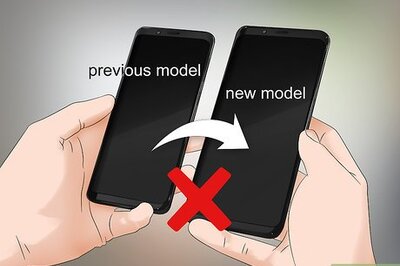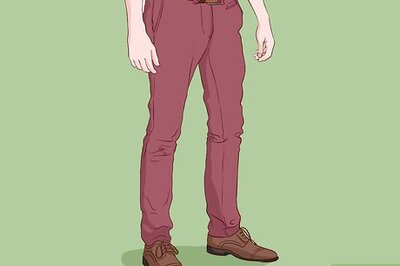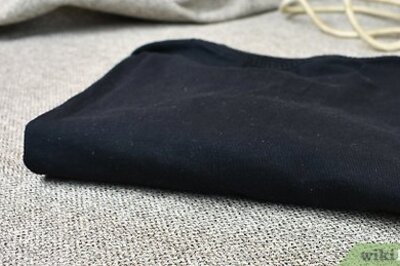
views
CHICAGO: Attorneys and witnesses have used the words reasonable or unreasonable often at the trial of the former Minneapolis police officer charged with murder and manslaughter in George Floyd s death.
Derek Chauvin’s defense attorney put the concept at the center of his closing argument on Monday.
Its no coincidence. The concept of reasonableness has been crucial at trials of officers ever since the landmark Graham v. Connor ruling 32 years ago by the U.S. Supreme Court.
Here is a look at the issue and the key role its likely to play as Chauvins trial draws to a close.
WHAT WAS GRAHAM V. CONNOR ABOUT?
Before the Graham v. Connor ruling in 1989, lower courts were often at odds about how to determine whether an officer on trial used an unreasonable, and therefore illegal, amount of force.
Graham v. Connor involved a 1984 arrest in North Carolina in which officers manhandled diabetic Dethorne Graham, brushing off his pleas for treatment when he said he was having a potentially deadly insulin reaction.
It bore some similarities to the arrest of Floyd last May 25, when Floyd repeatedly said he couldnt breathe as Chauvin, who is white, kneeled on the Black mans neck for nearly 9 1/2 minutes.
WHAT CRITERIA DID THE HIGH COURT SET?
In its unanimous opinion written by Chief Justice William Rehnquist, the court said whether an officer used a proper level of force had to be viewed from the officers perspective.
The reasonableness of a particular use of force must be judged from the perspective of a reasonable officer on the scene, rather than with the 20/20 vision of hindsight, Rehnquist wrote.
That means jurors must not consider what they would have done in Chauvins shoes, but rather, what any reasonable officer would have done under the same circumstances.
Among the implications of Graham v. Connor was that an officers actions leading to a suspects death may be legal if the officer believed his or her life was at risk even if, in hindsight, it becomes clear there was no such danger.
The assertion that an officers perception of fear could trump the actual danger has led to acquittals of many officers over the years. Jurors found four Los Angeles police officers not guilty in the 1991 beating of Rodney King after being instructed to use the Graham v. Connor criteria.
Some legal experts believed Chauvin might have wanted to testify because of the importance the high court placed on what an officer was thinking. Chauvin said Thursday he would not testify.
WHAT ABOUT THE JURY INSTRUCTIONS?
Before closing arguments began Monday, Hennepin County Judge Peter Cahill read aloud from jury instructions drawn up by the court with input from prosecutors and the defense.
Those instructions included a definition of the reasonable use of force that adhered closely to the wording in Graham v. Connor.
Cahill told jurors they would be allowed to take copies of the instructions to deliberate. Many jurors rely on instructions to help them interpret the evidence.
WHATS THE DEFENSE POSITION?
Defense attorney Eric Nelson used his closing argument Monday to focus juror’s attention on another portion of those instructions, directing jurors to decide whether Chauvin acted reasonably in light of the totality of the facts and circumstances.
Nelson said jurors have to consider all the information Chauvin had from dispatchers, his arrival as two officers struggled to push Floyd into a patrol car and the increasingly upset people standing nearby and loudly pleading with them to get off the Black man.
He played shaky footage captured by the three other officers’ body cameras as they unsuccessfully tried to get Floyd into the car’s backseat before pinning him to the ground.
You have to take into account that officers are human beings, capable of making mistakes in highly stressful situations, Nelson said. “In this case, the totality of the circumstances that were known to a reasonable police officer in the precise moment the force was used demonstrates that this was an authorized use of force, as unattractive as it may be, and this is reasonable doubt.
Nelson also called witnesses to tell jurors that suspects, especially large men like Floyd, can suddenly present a threat even if bystanders cant see that. Witness Barry Brodd, a former California police officer, testified that Floyd appeared to be under the influence of drugs.
They (those under the influence) may have superhuman strength, or they may have an ability to go from compliant to extreme noncompliance in a heartbeat, he said.
Brodd told jurors he believed Chauvin was justified, was acting with objective reasonableness in how he treated Floyd.
Nelson also sought during cross examination to undermine one state witness who had asserted that merely placing Floyd on his stomach in the first place even before Chauvin wedged his knee into his neck was unreasonable and excessive.
Reasonable minds can disagree, agreed? Nelson asked the witness, law professor Seth Stoughton.
On this particular point, no, he replied.
HOW HAVE PROSECUTORS EXPLAINED THE CONCEPT?
Some lawyers for officers charged in fatal shootings have won acquittals under those criteria by arguing their clients were in chaotic situations with mere seconds to decide whether to pull a trigger.
That wasnt Chauvins situation. Prosecutors have said its clear Chauvin faced no imminent threat and was never forced to make the kind of split-second decisions the high court envisioned.
They also called leaders in the Minneapolis Police Department, including the chief who testified that officers were not trained to hold suspects down by pressing a knee into the person’s neck as Chauvin did.
Prosecutor Steve Schleicher, delivering the state’s closing argument, said Chauvin did not act as a reasonable officer would. He again argued that a reasonable officer, particularly with Chauvin’s experience and training, would not consider the force he used against Floyd to be necessary.
You cannot justify this use of force, Schleicher said. “Its impossible. Not if you apply the rules, not if you apply the standards.”
During testimony, Schleicher asked one defense witness to explain how Floyd could have posed a continuous threat, even if he did momentarily, since he was handcuffed and pinned face down by Chauvins knee on his neck, as well as officers at his back and legs.
Would you agree that the application of use of force must be reasonable at the start and at the end (of an incident) and at all points in between? Schleicher asked the defense witness Brodd.
Brodd said he agreed.
___
Associated Press reporter Kathleen Foody contributed.
___
Follow Michael Tarm on Twitter at http://twitter.com/mtarm
___
Find APs full coverage of the death of George Floyd at: https://apnews.com/hub/death-of-george-floyd
Disclaimer: This post has been auto-published from an agency feed without any modifications to the text and has not been reviewed by an editor
Read all the Latest News, Breaking News and Coronavirus News here. Follow us on Facebook, Twitter and Telegram.




















Comments
0 comment